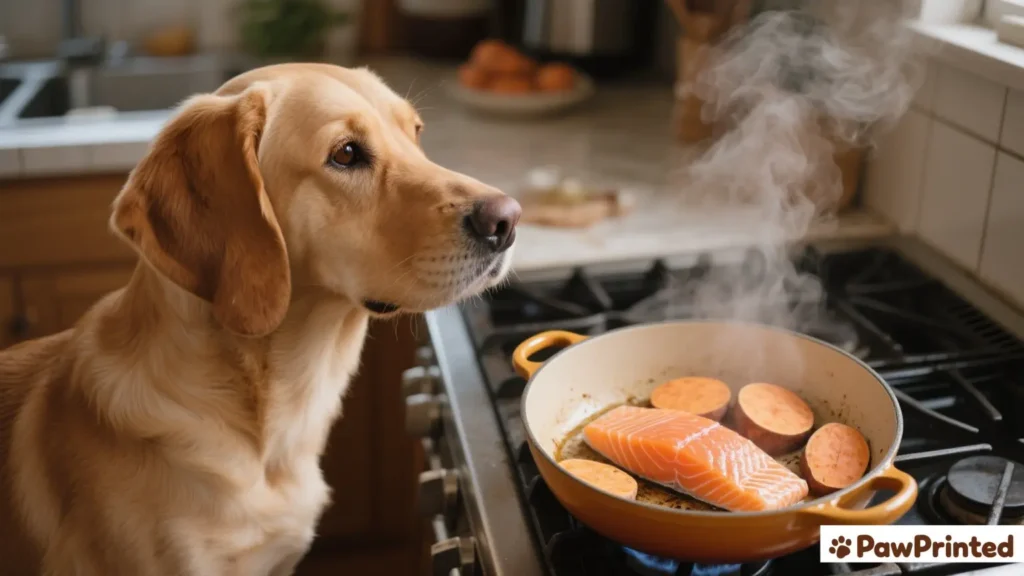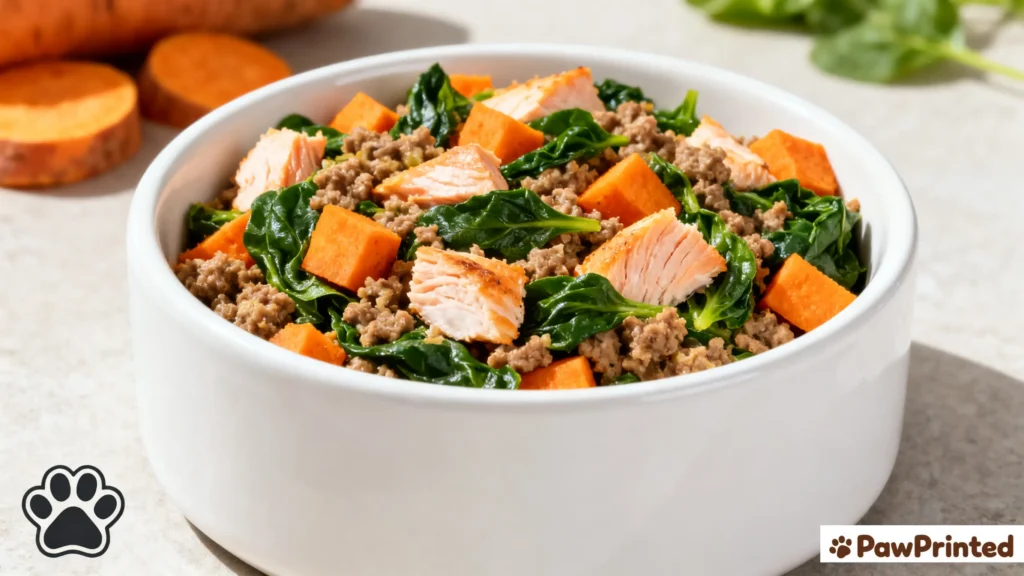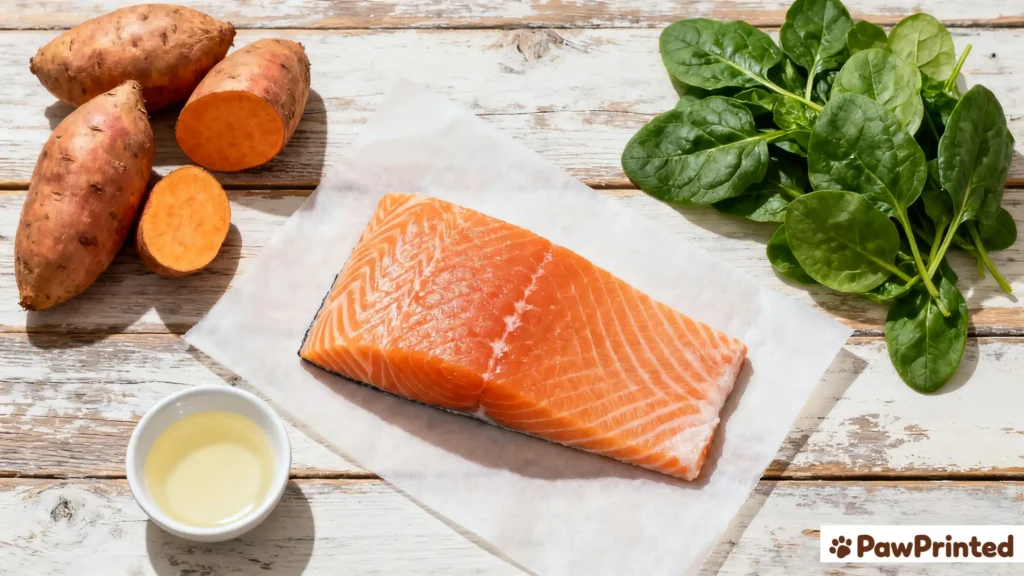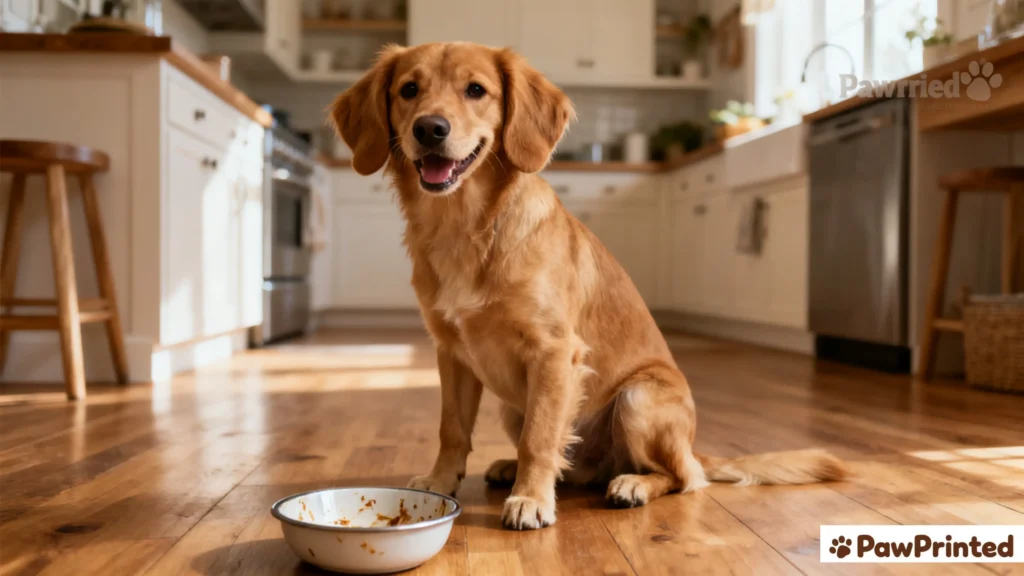Some weeks, Ethan’s coat looks glassy and smooth. Other weeks, he’s busy scratching, licking paws, and leaving little snow flurries on the couch. Our vet’s take was simple: most “itch cycles” calm down when diet gets boring—in a good way. This guide distills what actually helped us reduce flare-ups: skin-smart nutrients, gentle ingredients, and a measured feeding routine that you can keep steady for more than a weekend.
Red flag — call your vet: hot spots, open sores, ear infections with smell, rapid hair loss, or intense itching that wakes your dog at night. Sudden facial swelling or hives = emergency care.

Why Do Dogs Get Sensitive Skin?
“Sensitive skin” isn’t one thing. It’s usually a mix of triggers: food proteins your dog can’t tolerate, environmental allergens (pollen, dust mites), or nutrition gaps that weaken the skin barrier. We’ve seen three patterns repeat:
- Food triggers: some dogs react to common proteins or additive-heavy diets. A limited-ingredient plan helps isolate culprits. If chicken has been an issue, a gentler alternative like lamb can help; see our Lamb vs Chicken guide.
- Fatty-acid imbalance: low omega-3 intake keeps inflammation “loud.”
- Transition chaos: too many changes, too fast. Keep swaps slow with our transition guide.
Skin-Smart Nutrients (What Actually Helps)
- Omega-3s (EPA/DHA): turn down inflammatory signals; support glossy coat. Sources: salmon, sardine, fish oil. See our salmon dog food hub.
- Balanced Omega-6: needed for barrier repair—keep ratio in check (don’t overload high-omega-6 oils without omega-3s).
- Vitamin E & Zinc: antioxidant + skin turnover support.
- High-quality, well-tolerated protein: consistent amino acids for hair follicles and barrier integrity. If allergens are suspected, start with a LID protein. Wondering whether lamb is truly hypoallergenic? Here’s our explainer: Are Lamb Dog Foods Really Hypoallergenic?
- Probiotics: gut-skin axis matters—see probiotics for dogs.

Best Ingredients for Sensitive Skin Dogs
Think “plain and predictable.” Rotate slowly and track response for 10–14 days per change. If chicken has triggered flares before, try lamb-focused LID options from our lamb dog food guide.
| Ingredient | Why It Helps | Best Use |
|---|---|---|
| Salmon / Sardine | Rich EPA/DHA to calm itch | Primary protein or topper (measured) |
| Lamb (LID) | Gentler alternate to chicken for many dogs | Single-protein LID base; slow transition |
| Oatmeal / Brown rice | Steady, easy carbs that don’t spike | Bind stools; steady energy |
| Sweet potato | Beta-carotene + fiber for gut support | Side carb; mash well |
| Blueberries | Antioxidants for skin defense | Small topper (not a main carb) |
| Fish oil (measured) | Concentrated omega-3s | Daily micro-dose with vet input |

Foods & Additives to Be Careful With
- Known triggers for your dog: if beef, chicken, or certain grains previously flared itch, don’t “test” during recovery weeks. See Lamb vs Chicken if you’re weighing a switch.
- High-fat scraps & processed treats: can inflame skin and gut.
- Colorants / heavy flavorings: more noise than value.
Not every dog needs grain-free. If you’re considering it, see the pros/cons in our Grain-Free Guide first.
Our Simple Feeding Routine for Calmer Skin
- Pick one base: a skin-smart LID or salmon-forward formula. Keep everything else the same for 10–14 days. If you must switch, use the 7-day transition.
- Micro-dose omega-3s: measure fish oil by weight; log coat/itch every 3–4 days.
- Probiotic support: one product at a time; see our probiotics guide.
- Groom & rinse: oatmeal-based gentle baths and regular brushing keep allergens off the skin surface.

Who Benefits Most (and Who Needs Extra Care)
Good candidates: itchy paws, mild dandruff, seasonal flares, dull coat. Use extra caution: dogs with recurrent ear infections, raw skin lesions, or suspected deep allergies—loop in your vet and consider a formal elimination diet.
FAQ
What’s the best protein for sensitive skin?
There’s no universal winner—pick a well-tolerated protein and stay consistent. Salmon and turkey are common starters. If food allergy is suspected, try a limited-ingredient formula so you can isolate variables.
Do grain-free diets help itchy skin?
Sometimes—but grains aren’t the only trigger. Many dogs do well with gentle carbs like oatmeal or rice. Review pros/cons in our Grain-Free Guide before switching.
How long until I see improvement?
Mild cases: 2–4 weeks with a steady plan. Chronic cases can take 8–12 weeks. Track itch scores, paw-licking time, and coat shine weekly. Use the transition guide for safe changes.
Should I add supplements?
Omega-3s and probiotics have the strongest day-to-day upside. Ask your vet about dose by weight, and make one change at a time so you can judge effect.
Is lamb good for dogs with sensitive skin?
Often yes. Lamb is a gentler alternative to chicken for many itchy pups, especially in limited-ingredient formulas where you can control variables. For a deep dive, see our lamb dog food guide and the comparison Lamb vs Chicken.
Note: If daily cooking isn’t your plan, a steady store base plus measured omega-3s and a clean transition schedule can still deliver calmer skin days.

Wrapping It Up
What finally worked for Ethan looked boring on paper: a clean base, fish-oil measured by weight, gentle carbs, and fewer surprises. Boring fed us better weeks—less scratching, brighter coat, and more naps in the sun. If you’re starting fresh, keep the plan simple and use your notes like a compass. Your dog will tell you what’s working—quietly, with fewer itches.
Follow PawPrinted on Pinterest
Follow us for sensitive skin dog food recipes, grooming hacks, and vet-approved feeding tips. Save ideas you love and build a calm-skin routine that sticks.

